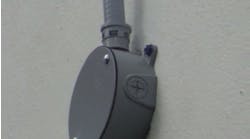Article 675 provides the requirements for electrically driven or controlled irrigation machines, and their branch circuits and controllers.
But exactly what are these machines? According to the NEC, they
- Have an electric motor
- Are not hand-portable
- Are used primarily to transport and distribute water for irrigation.
Drive along the Interstate in the “farm belt” (but not near large cities), and you will likely see these machines.
Some highlights from this section of the Code include:
- To interconnect enclosures on the structure of the machine, only conductors of an insulation type listed in Table 310.104(A) can be used [675.4(A)].
- An interconnection cable can contain power, control, and grounding conductors [675.4(A)].
- Irrigation cable must be supported at intervals not exceeding 4 ft [675.4(C)].
- For ampacity adjustments per 310.15(B)(3)(a), count only the power cables [675.5].
- The main disconnect for the machine must provide overcurrent protection, be at the point of connection of electric power to the machine, be in sight from the machine, and be readily accessible and lockable [675.8(B)].
- Requirements for collector rings used for power are in 675.11.




